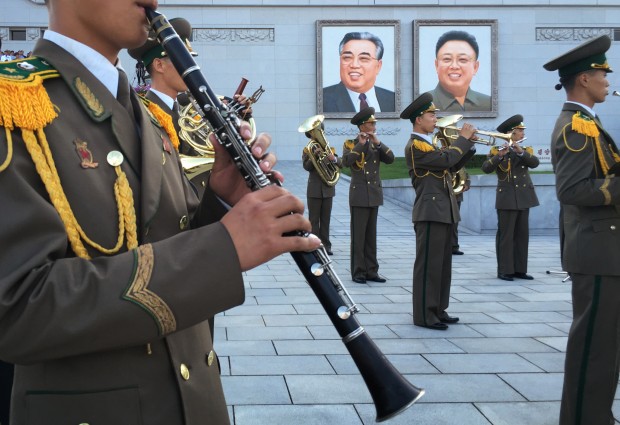Alliance of convenience

North Korean military band members play their instruments in front of portraits of the late North Korean leaders Kim Il Sung and Kim Jong Il during an anti-U.S. rally attended by thousands of North Koreans to mark the 66th anniversary of the start of the Korean War at the Kim Il Square on Saturday, June 25, 2016, in Pyongyang, North Korea. (AP Photo/Wong Maye-E)
Many, if not most, Westerners with a passing interest in North Korea tend to believe that in the bygone days of the Communist bloc the Soviet Union and North Korea were close allies. This is a gross mistake.
While relations between Moscow and Pyongyang were initially quite close, from the late 1950s they deteriorated rapidly and significantly. Hence, the 1960 to 1990 period can be best described as a time of a pragmatic alliance driven not by any ideological solidarity but rather by cold, practical geopolitical concerns.
It is true that the North Korean state came into existence in the late 1940s as a result of Soviet-inspired and Soviet-controlled social engineering. It might be a bit excessive to describe North Korea in 1945-50 as a “Soviet puppet state”, but the level of micromanagement of North Korean affairs by Soviet officials stationed in the country then was high.
However, it was not only the Soviets who were using Kim Il-sung, but also Kim using the Soviets, and at the end of the day, it was Kim who came out on top. In the 1950s, while still producing large quantities of pro-Soviet, politically correct rhetoric, Kim Il-sung gradually removed all officials too close to Moscow. Many of these people were former Soviet officials of Korean ethnic extraction dispatched to North Korea before the Korean War. In the late 1950s, skillfully utilizing growing hostility between the Soviet Union and China, Kim Il-sung managed nearly completely to rid his country of Soviet influence, becoming arguably the most independent of all communist rulers at the time.
Relations between Moscow and Pyongyang had turned sour, with several North Korean officials and intellectuals, including the then North Korean ambassador in Moscow, defecting and granted asylum _ much to the chagrin of Pyongyang. At the same time, purges of pro-Soviet elements continued, and the most well known were either exiled or imprisoned, but the less well known suffered much, perishing in labor camps or mining colonies. Intellectuals close to Russia were also largely purged.
In the early 1960s, the North Korean government moved to dissolve mixed marriages. Those North Koreans who had studied in the USSR and had married Soviet citizens (mainly North Korean men to Soviet women) were ordered to get divorced or be exiled. Soviet citizens were then either forcibly deported or not allowed to return when they visited relatives in the USSR.
The purge of Soviet publications also began. Most translations of Soviet fiction were suddenly found to be ideologically suspect and moved to special sections of libraries closed to the public. After 1967, it even became illegal to keep foreign (including Soviet) literature at home, though this ban ceased to be enforced in the early 1980s (maybe due to the rise of Kim Jong-il).
At the same time, academic and cultural exchanges were dramatically reduced or halted. In 1958, after the defection of some North Korean students in Moscow (all of them were granted asylum by Soviet authorities), the North Korean government decided not to allow its students to study abroad in other socialist bloc countries. In Bulgaria, then the closest Soviet ally in Europe, the group defection of North Korean students (all granted asylum by the Bulgarian government) led to a complete interruption of diplomatic relations, which remained frozen for a few years in the 1960s. Student exchanges with the Communist bloc were only resumed in the late 1970s.
In 1962-4, postal exchanges between North Korea and the Soviet Union were effectively halted, again only to resume some 15 years later in the late 1970s. North Korean letter writers sometimes got their letters back marked “addressee unknown”, or just didn’t get a response. Only increasingly rare visitors were able occasionally to smuggle in letters.
The Soviet Union also did not show much sympathy toward North Korea in those decades. The Soviet media remained largely silent about North Korea, while the majority of “fraternal” communist countries enjoyed extensive coverage in the Soviet newspapers of the period. In lectures for party activists and education personnel (technically off-limits to the public), selected attendees were told rather critical (if generally correct) stories about North Korea’s mad personality cult and growing economic problems, as well as its rather tense relations with the Soviet Union.
Despite this, Soviet aid continued to flow into North Korea because the Soviet Union needed the country as a buffer near its eastern borders and also did not want Pyongyang to side with Beijing in the intense Sino-Soviet dispute of the period. Nonetheless, relations remained testy until the mid-1980s, when they briefly improved only to collapse again around 1990. So, it might have been an alliance, but it must have been an uneasy one.










































